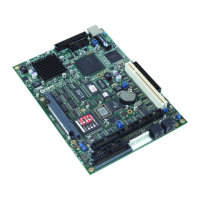SBC-GX1 Technical Manual Detailed hardware description
CPU temperature sensor
An National Semiconductor LM84 temperature monitor IC is fitted to the board. This
device can be used to monitor the CPU die temperature and the board temperature. It
provides feedback if the temperature rises above a predefined level. The LM84 has an
I
2
C bus interface and is connected to three I/O lines. Two of these lines are from the
CS5530 and one is from the Super I/O controller. The following table shows the
connection details:
Pin Name Device LM84 Signal Name
GPIO3 CS5530 DATA
GPIO2 CS5530 CLOCK
GPIO10 PC97317 ALERT*
Data sheets for the LM84, CS5530, I
2
C specification and NS97317 are supplied on the
support CD. There is also an example program that shows how to configure the device
and check the output level. The output from the LM84 is normally high, but will go to
logic ‘0’ when the threshold level is reached. The output stays at logic ‘0’ until the
temperature has fallen below the hysterises level. This output can be used to slow
down the CPU and provide user warning if the ambient temperature becomes
excessive.
The BIOS can be used to set the trip level for both the local and remote temperature
sensors. The current temperature can also be read while the BIOS is in the setup
screen.
PC/104 interface
The PC/104 interface supports 8/16 bit ISA style signals. Add-on boards can be used to
enhance the functionality of the main board. The PC/104 standard has been adopted by
a wide range of companies and boards are available which support various types of
interface. This bus can be used to add digital I/O, analog I/O, serial ports, video capture
devices, PC CARD interfaces etc.
Any board plugged into this interface will be accessed as if it were part of the main
board, therefore it may conflict with I/O and memory devices on-board if it has not been
correctly configured. Before using an expansion board you should check that it can be
configured to work along side the peripherals already incorporated on-board.
The PC/104 bus signals are fully compatible with the ISA bus electrical timing
definitions. Some IRQ and DMA signal lines may be associated with on-board devices
and therefore are not free to be used by add-on boards.
© 2004 Arcom Issue D 77

